Marie-Luise Kapsch
| Abteilung | Klimavariabilität |
| Gruppe | Physik des Ozeans |
| Position | Research Scientist |
| Telefon | +49 40 41173-415 |
| marie-luise.kapsch@mpimet.mpg.de | |
| Raum | B 231 |
Forschungsinteressen
Meine derzeitige Forschung konzentriert sich auf ein besseres Verständnis der Antriebskräfte der Klimavariabilität während der letzten Termination (ca. 26,000 Jahre vor heute bis heute) und darauf, wie wir dieses Wissen nutzen können, um die Unsicherheiten von Zukunftsprognosen (z. B. in Bezug auf klimatische Kipppunkte) besser einschätzen zu können. Dazu verwende ich ein gekoppeltes Klima-Eisschild-Modell oder Teilmodelle davon. Das Modell kann für eine Reihe von Anwendungen eingesetzt werden, ist aber von besonderer Bedeutung für ein besseres Verständnis der Wechselwirkungen und Rückkopplungen zwischen Eisschilden und dem Klimasystem. Meine derzeitigen Arbeiten sind Teil der deutschen Paläomodellierungsinitiative PalMod.
Forschungshighlights
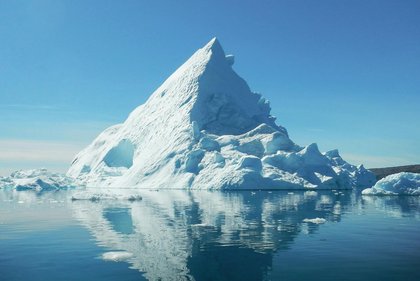
Klimamodell enthüllt Auslöser abrupter Klimaveränderungen
Zwischen dem Höhepunkt der letzten Eiszeit und heute waren Menschen starken Klimaänderungen ausgesetzt: Aufgrund des steigenden Meeresspiegels gingen Küstensiedlungsgebiete verloren, und wiederkehrende Phasen starker abrupter Abkühlungsereignisse zwangen sie zur Anpassung. Die Ursache dieser starken Temperaturschwankungen in den vergangenen 20 000 Jahren konnten wir mithilfe eines neuartigen gekoppelten Klima-Eisschild-Modells bestimmen.
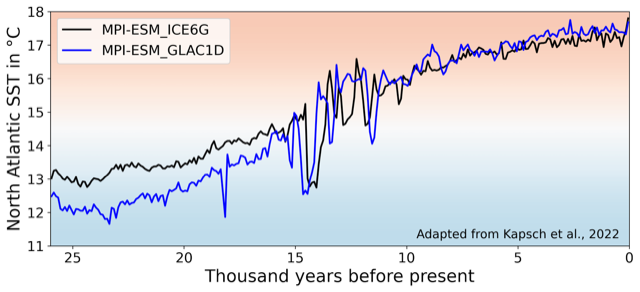
Was bestimmt die Variabilität der letzten Termination?
Der Übergang von der letzten Eiszeit in die heutige Warmzeit ging mit einer signifikanten Erwärmung, dem Abschmelzen großer Landeismassen und einer Reihe von abrupten Klimaänderungen einher. Anhand eines Ensembles von Simulationen dieses Übergangs mit vorgegebenen Eisschilden aus unterschiedlichen Rekonstruktionen konnten wir zeigen, dass unser Modellsystem sowohl die langzeitlichen Klimaänderungen als auch die abrupten Klimaänderungen simuliert. Die genaue Abfolge der abrupten Ereignisse hängt jedoch wesentlich von der durch die Eisschild-Rekonstruktion vorgegebenen Eisschildausdehnung und -höhe ab.
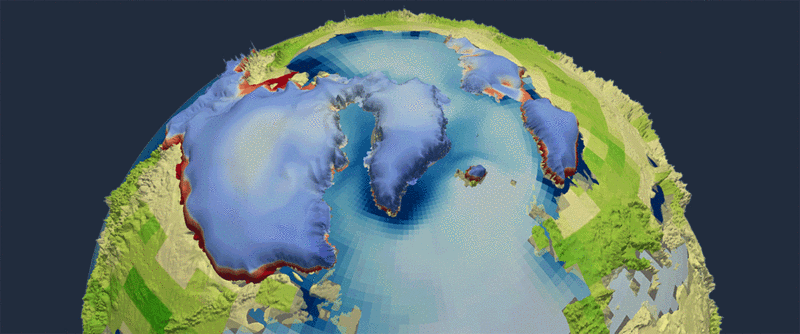
Großforschungsprojekt PalMod: was haben wir gelernt?
Das vom Bundesministerium für Bildung und Forschung (BMBF) geförderte Projekt PalMod (kurz für Paläo-Modellierung) untersucht das Klimasystem und seine Variabilität im letzten Eiszeitzyklus mit komplexen Erdsystemmodellen. Dank der Modelle lassen sich Prozesse, welche auch für das heutige Klima relevant sind, besser verstehen. Eine ausführliche Darstellung bisherhiger Arbeiten finden sich auf den folgenden Seiten.

Wie Dansgaard-Oeschger Zyklen Heinrich Ereignisse beeinflussen
Die Klimaentwicklung während der letzten Eiszeit (ca. 65.000-15.000 Jahre vor heute) wurde von zwei prominenten Signalen der Klimavariabilität geprägt: den Dansgaard-Oeschger Zyklen und den Heinrich-Ereignissen. In einer aktuellen Studie stellen wir einen neuen Mechanismus vor, der erklärt, wie Heinrich-Ereignisse mit Dansgaard-Oeschger-Zyklen synchronisiert werden.
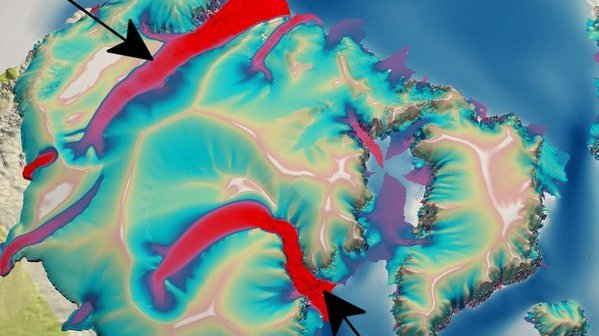
Der Einfluss von Klimastörungen auf das Timing von Heinrich-Ereignissen
Während der letzten Eiszeit prägten periodische Instabilitäten des nordamerikanischen Eisschildes die klimatische Entwicklung der nördlichen Hemisphäre (sogenannte Heinrich-Ereignisse). In einer neuen Studie untersuchen wir die Sensitivität der Heinrich-Ereignisse gegenüber verschiedenen Klimaantrieben.
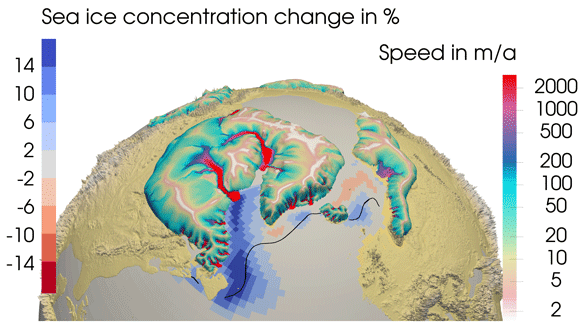
Wie beeinflussen Heinrich-Ereignisse das Klima?
In unseren Modellsimulationen werden Heinrich-Ereignisse durch quasi-periodische Instabilitäten der Eisschilde ausgelöst. Während dieser Ereignisse werden große Mengen an Eisbergen freigesetzt und dem Ozean als Süßwasser hinzugefügt. Dies hat weitreichende Auswirkungen auf die Klimaentwicklung in Nordamerika und Europa.
Veröffentlichungen
- Mikolajewicz, U., Kapsch, M.-L., Schannwell, C., Six, K. D., Ziemen, F. A., Bagge, M., Baudouin, J.-P., Erokhina, O., Gayler, V., Klemann, V., Meccia, V. L., Mouchet, A., and Riddick, T., 2025. Deglaciation and abrupt events in a coupled comprehensive atmosphere–ocean–ice-sheet–solid-earth model, Clim. Past, 21, 719–751, doi:10.5194/cp-21-719-2025.
- Andernach, M., Kapsch, M.-L., and Mikolajewicz, U., 2025. Impact of Greenland Ice Sheet disintegration on atmosphere and ocean disentangled, Earth Syst. Dynam., 16, 451–474, doi:10.5194/esd-16-451-2025.
- Ziegler, E., Weitzel, N., Baudouin, J.-P., Kapsch, M.-L., Mikolajewicz, U., Gregoire, L., Ivanovic, R., Valdes, P. J., Wirths, C., and Rehfeld, K., 2025: Patterns of changing surface climate variability from the Last Glacial Maximum to present in transient model simulations, Clim. Past, 21, 627–659, doi:10.5194/cp-21-627-2025.
- Weitzel, N., Andres, H., Baudouin, J.-P., Kapsch, M.-L., Mikolajewicz, U., Jonkers, L., Bothe, O., Ziegler, E., Kleinen, T., Paul, A., and Rehfeld, K., 2024. Towards spatio-temporal comparison of simulated and reconstructed sea surface temperatures for the last deglaciation, Clim. Past, 20, 865–890, doi.org/10.5194/cp-20-865-2024.
- Schannwell, C., Mikolajewicz, U., Kapsch, M-L., Ziemen, A., 2024. A mechanism for reconciling the synchronisation of Heinrich events and Dansgaard-Oeschger cycles. Nat Commun 15, 2961. doi.org/10.1038/s41467-024-47141-7.
- Snoll, B., Ivanovic, R., Gregoire, L., Sherriff-Tadano, S., Menviel, L., Obase, T., Abe-Ouchi, A., Bouttes, N., He, C., He, F., Kapsch, M.-L., Mikolajewicz, U., Muglia, J., and Valdes, P., 2024. A multi-model assessment of the early last deglaciation (PMIP4 LDv1): a meltwater perspective, Clim. Past, 20, 789–815, doi.org/10.5194/cp-20-789-2024.
- Schannwell, C., Mikolajewicz, U., Ziemen, F., and Kapsch, M.-L., 2023. Sensitivity of Heinrich-type ice-sheet surge characteristics to boundary forcing perturbations, Clim. Past, 19, 179–198, doi:10.5194/cp-19-179-2023.
- Kapsch, M.-L., Mikolajewicz, U., Ziemen, F., & Schannwell, C., 2022. Ocean response in transient simulations of the last deglaciation dominated by underlying ice-sheet reconstruction and method of meltwater distribution. Geophysical Research Letters, 49, e2021GL096767. doi:10.1029/2021GL096767.
- Kageyama, M., Harrison, S. P., Kapsch, M.-L., Lofverstrom, M., Lora, J. M., Mikolajewicz, U., Sherriff-Tadano, S., Vadsaria, T., Abe-Ouchi, A., Bouttes, N., Chandan, D., Gregoire, L. J., Ivanovic, R. F., Izumi, K., LeGrande, A. N., Lhardy, F., Lohmann, G., Morozova, P. A., Ohgaito, R., Paul, A., Peltier, W. R., Poulsen, C. J., Quiquet, A., Roche, D. M., Shi, X., Tierney, J. E., Valdes, P. J., Volodin, E., and Zhu, J., 2021. The PMIP4 Last Glacial Maximum experiments: preliminary results and comparison with the PMIP3 simulations. Clim. Past, 17, 1065–1089, doi:10.5194/cp-17-1065-2021.
- Kapsch, M.-L., Mikolajewicz, U., Ziemen, F. A., Rodehacke, C. B., and Schannwell, C., 2021. Analysis of the surface mass balance for deglacial climate simulations. The Cryosphere, 15, 1131–1156, doi:10.5194/tc-15-1131-2021.
- Renoult, M., Annan, J. D., Hargreaves, J. C., Sagoo, N., Flynn, C., Kapsch, M.-L., Li, Q., Lohmann, G., Mikolajewicz, U., Ohgaito, R., Shi, X., Zhang, Q., and Mauritsen, T., 2020. A Bayesian framework for emergent constraints: case studies of climate sensitivity with PMIP. Clim. Past, 16, 1715–1735, doi:10.5194/cp-16-1715-2020.
- Fettweis, X., Hofer, S., Krebs-Kanzow, U., Amory, C., Aoki, T., Berends, C. J., Born, A., Box, J. E., Delhasse, A., Fujita, K., Gierz, P., Goelzer, H., Hanna, E., Hashimoto, A., Huybrechts, P., Kapsch, M.-L., King, M. D., Kittel, C., Lang, C., Langen, P. L., Lenaerts, J. T. M., Liston, G. E., Lohmann, G., Mernild, S. H., Mikolajewicz, U., Modali, K., Mottram, R. H., Niwano, M., Noël, B., Ryan, J. C., Smith, A., Streffing, J., Tedesco, M., van de Berg, W. J., van den Broeke, M., van de Wal, R. S. W., van Kampenhout, L., Wilton, D., Wouters, B., Ziemen, F., and Zolles, T., 2020. GrSMBMIP: Intercomparison of the modelled 1980–2012 surface mass balance over the Greenland Ice Sheet. The Cryosphere, 14, 3935–3958, doi:10.5194/tc-14-3935-2020.
- Ziemen, F. A., Kapsch, M.-L., Klockmann, M., and Mikolajewicz, U., 2019. Heinrich events show two-stage climate response in transient glacial simulations. Clim. Past, 15, 153–168, doi:10.5194/cp-15-153-2019.
- Kapsch, M.-L., N. Skific, R. G. Graversen, M. Tjernström, and J. A. Francis, 2019. Summers with low Arctic sea ice linked to persistence of spring atmospheric circulation patterns. Clim. Dyn., 52, 2497–2512, doi:10.1007/s00382-018-4279-z.
- Mikolajewicz, U., Ziemen, F., Cioni, G., Claussen, M., Fraedrich, K., Heidkamp, M., Hohenegger, C., Jimenez de la Cuesta, D., Kapsch, M.-L., Lemburg, A., Mauritsen, T., Meraner, K., Röber, N., Schmidt, H., Six, K. D., Stemmler, I., Tamarin-Brodsky, T., Winkler, A., Zhu, X., and Stevens, B., 2018. The climate of a retrograde rotating earth. Earth Syst. Dynam., 9, 1191-1215, doi:10.5194/esd-9-1191-2018.
- Mortin, J., G. Svensson, R.G. Graversen, M.-L. Kapsch, J.C. Stroeve, and L.N. Boisvert, 2016. Melt onset over Arctic sea ice controlled by atmospheric moisture transport. Geophys. Res. Lett., 43, 6636-6642, doi:10.1002/2016GL069330.
- Kapsch, M.-L., R.G. Graversen, M. Tjernström, R. Bintanja, 2016. The effect of downwelling longwave and shortwave radiation on Arctic summer sea ice. J. Clim., 29,1143-1159, doi:10.1175/JCLI-D-15-0238.1.
- Kapsch, M.-L., R. G. Graversen, T. Economou, and M. Tjernström, 2014. The importance of spring atmospheric conditions for predictions of the Arctic summer sea ice extent. Geophys. Res. Lett., 41, 5288–5296, doi:10.1002/2014GL060826.
- Kapsch, M.-L., R. G. Graversen, M. Tjernström, 2013. Springtime atmospheric energy transport and the control of Arctic summer sea-ice extent. Nature Clim. Change, 3, 744–748, doi:10.1038/nclimate1884.
- Kapsch, M.-L., M. Kunz, R. Vitolo, T. Economou, 2012. Long-term trends of hail-related weather types in an ensemble of regional climate models using a Bayesian approach. J. Geophys. Res., 117, D15107, doi:10.1029/2011JD017185.
- Obase, T., Menviel, L., Abe-Ouchi, A., Vadsaria, T., Ivanovic, R., Snoll, B., Sherriff-Tadano, S., Valdes, P., Gregoire, L., Kapsch, M.-L., Mikolajewicz, U., Bouttes, N., Roche, D., Lhardy, F., He, C., Otto-Bliesner, B., Liu, Z., and Chan, W.-L., 2023. Multi-model assessment of the deglacial climatic evolution at high southern latitudes, Clim. Past Discuss. [preprint], doi.org/10.5194/cp-2023-86, in review.
- Kapsch, M.-L. and C. Schannwell. Eisschilde als Klimafaktor. Max-Planck Gesellschaft. Jahrbuch-Highlights, 2022. https://www.mpg.de/jahrbuch-highlights
- Kapsch, M.-L. The atmospheric contribution to Arctic sea-ice variability. Stockholm: Department of Meteorology, Stockholm University, 2015. PhD Thesis. http://urn.kb.se/resolve?urn=urn:nbn:se:su:diva-119779
- Kapsch, M.-L. Longterm variability of hail-related weather types in an ensemble of regional climate models. Institute for Meteorology and Climate Research, Karlsruhe Institute of Technology, 2011. Diploma thesis.https://www.imk-tro.kit.edu/english/4327_5235.php
- Kapsch, M.-L., H. Eicken, M. Robards, 2010. Sea ice distribution and ice use by indigenous walrus hunters on St. Lawrence Island, Alaska. In: SIKU: Knowing Our Ice: Documenting Inuit Sea Ice Knowledge and Use; edited by I. Krupnik, et al. Springer, Berlin. https://seaice.alaska.edu/gi/publications/eicken/10KER.pdf
- Kapsch, M.-L. Bestimmung turbulenter Energie- und Stoffflüsse über inhomogenem Gelände während COPS, 2009. Seminararbeit, Karlsruhe.
- Mikolajewicz, U., M.-L. Kapsch, V. Gayler, V. Meccia, T. Riddick, F. Ziemen, C. Schannwell, 2023. PalMod2 MPI-M MPI-ESM1-2-CR Transient simulations of the last deglaciation with prescribed ice sheets from GLAC-1D reconstructions (r1i1p1f1). World Data Center for Climate (WDCC) at DKRZ. https://doi.org/10.26050/WDCC/PMMXMCRTDGP111
- Mikolajewicz, U., M.-L. Kapsch, V. Gayler, V. Meccia, T. Riddick, F. Ziemen, C. Schannwell, 2023. PalMod2 MPI-M MPI-ESM1-2-CR Transient simulations of the last deglaciation with prescribed ice sheets from GLAC-1D reconstructions (r1i1p2f2). WDCC at DKRZ. https://doi.org/10.26050/WDCC/PMMXMCRTDGP122
- Mikolajewicz, U., M.-L. Kapsch, V. Gayler, V. Meccia, T. Riddick, F. Ziemen, C. Schannwell, 2023. PalMod2 MPI-M MPI-ESM1-2-CR Transient simulations of the last deglaciation with prescribed ice sheets from GLAC-1D reconstructions (r1i1p3f2). WDCC at DKRZ. https://doi.org/10.26050/WDCC/PMMXMCRTDGP132
- Mikolajewicz, U., M.-L. Kapsch, V. Gayler, V. Meccia, T. Riddick, F. Ziemen, C. Schannwell, 2023. PalMod2 MPI-M MPI-ESM1-2-CR Transient simulations of the last deglaciation with prescribed ice sheets from ICE-6G reconstructions (r1i1p1f1). WDCC at DKRZ. https://doi.org/10.26050/WDCC/PMMXMCRTDIP111
- Mikolajewicz, U., M.-L. Kapsch, V. Gayler, V. Meccia, T. Riddick, F. Ziemen, C. Schannwell, 2023. PalMod2 MPI-M MPI-ESM1-2-CR Transient simulations of the last deglaciation with prescribed ice sheets from ICE-6G reconstructions (r1i1p2f2). WDCC at DKRZ. https://doi.org/10.26050/WDCC/PMMXMCRTDIP122
- Mikolajewicz, U., M.-L. Kapsch, V. Gayler, V. Meccia, T. Riddick, F. Ziemen, C. Schannwell, 2023. PalMod2 MPI-M MPI-ESM1-2-CR Transient simulations of the last deglaciation with prescribed ice sheets from ICE-6G reconstructions (r1i1p3f2). WDCC at DKRZ. https://doi.org/10.26050/WDCC/PMMXMCRTDIP132
- Kapsch, M.-L., U. Mikolajewicz, F. Ziemen, C. Rodehacke, and C. Schannwell, 2020. Analysis of the Surface Mass Balance for Deglacial Climate Simulations. Dataset at DKRZ. http://hdl.handle.net/21.14106/bc8096febcf548ec640889d3888ad97f046f229e
- Jungclaus, J., U., Mikolajewicz, M.-L. Kapsch, et al., 2019. MPI-M MPI-ESM1.2-LR model output prepared for CMIP6 PMIP lgm. Earth System Grid Federation (ESGF). https://doi.org/10.22033/ESGF/CMIP6.6642
- Jungclaus, J., U., Mikolajewicz, M.-L. Kapsch, et al., 2019. MPI-M MPI-ESM1.2-LR model output prepared for CMIP6 PMIP midHolocene. ESGF. https://doi.org/10.22033/ESGF/CMIP6.6644
- Ziemen, F. A., Kapsch, M.-L., Klockmann, M., and U. Mikolajewicz, 2018. Long fully coupled transient ice sheet - climate simulations. http://hdl.handle.net/21.14106/2b75495d0a6f24a40aaacf41f777fa56f81c8b6c
